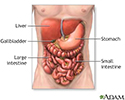Visceral larva migrans
Parasite infection - visceral larva migrans; VLM; Toxocariasis; Ocular larva migrans; Larva migrans visceralis
Visceral larva migrans (VLM) is a human infection with certain parasites found in the intestines of dogs and cats.
Causes
VLM is caused by roundworms (Toxocara) that are found in the intestines of dogs and cats.
Eggs produced by these worms are in the feces of the infected animals. The feces mix with soil. Humans can get sick if they accidentally eat soil that has roundworm eggs in it. This can happen by eating fruit or vegetables that were in contact with infected soil and were not washed thoroughly before eating. People can also become infected by eating raw liver from a chicken, lamb, or cow.
Young children or people with pica are at high risk for getting VLM. Pica is a disorder involving eating inedible things such as dirt and paint. Most infections in the United States occur in children who play in areas such as sandboxes, which contain soil contaminated by dog or cat feces.
After the worm eggs are swallowed, they break open in the intestine. The worms travel throughout the body to various organs, such as the lungs, liver, and eyes. They may also travel to the brain and heart.
Symptoms
Mild infections may not cause symptoms.
Serious infections may cause these symptoms:
- Abdominal pain
- Cough, wheezing
- Fever
- Irritability
- Itchy skin (hives)
- Shortness of breath
If the eyes are infected, loss of vision and crossed eyes can occur.
Exams and Tests
People with VLM usually seek medical care if they have a cough, fever, wheezing, and other symptoms. They may also have a swollen liver because it is the organ most affected.
Your health care provider will perform a physical exam and ask about the symptoms. If VLM is suspected, tests that may be done include:
- Complete blood count (CBC)
- Blood tests to detect antibodies to Toxocara
Treatment
This infection usually goes away on its own and may not require treatment. Some people with a moderate to severe infection need to take anti-parasitic medicines.
Outlook (Prognosis)
Severe infections involving the brain or heart can result in death, but this is rare.
Possible Complications
These complications may occur from the infection:
- Blindness
- Worsened eyesight
- Infection of the brain (encephalitis)
- Heart rhythm problems
- Difficulty breathing
When to Contact a Medical Professional
Contact your provider if you develop any of these symptoms:
- Cough
- Difficulty breathing
- Eye problems
- Fever
- Rash
A full medical exam is needed to check for VLM. Many conditions cause similar symptoms.
Prevention
Prevention includes deworming dogs and cats and preventing them from defecating in public areas. Children should be kept away from areas where dogs and cats may defecate.
It is very important to wash your hands thoroughly after touching soil or after touching cats or dogs. Teach your children to wash their hands thoroughly after being outdoors or after touching cats or dogs.
Do not eat raw liver from chickens, lambs, or cows.
References
Dobbs KR, Dent AE. Toxocariasis (visceral and ocular larva migrans). In: Kliegman RM, St. Geme JW, Blum NJ, et al, eds. Nelson Textbook of Pediatrics. 22nd ed. Philadelphia, PA: Elsevier; 2025:chap 344.
Kim K, Weiss LM. Parasitic infections. In: Broaddus VC, Ernst JD, King TE, et al, eds. Murray and Nadel's Textbook of Respiratory Medicine. 7th ed. Philadelphia, PA: Elsevier; 2022:chap 58.
Marcdante KJ, Kliegman RM, Schuh AM. Parasitic diseases. In: Marcdante KJ, Kliegman RM, Schuh AM, eds. Nelson Essentials of Pediatrics. 9th ed. Philadelphia, PA: Elsevier; 2023:chap 123.
Nash TE. Visceral larva migrans and other uncommon helminth infections. In: Bennett JE, Dolin R, Blaser MJ, eds. Mandell, Douglas, and Bennett's Principles and Practice of Infectious Diseases. 9th ed. Philadelphia, PA: Elsevier; 2020:chap 290.
Weatherhead JE, Hotez PJ. Parasitic nematode infections. In: Cherry JD, Kaplan SL, Harrison GJ, et al, eds. Feigin and Cherry's Textbook of Pediatric Infectious Diseases. 9th ed. Philadelphia, PA: Elsevier; 2025:chap 242.
Review Date: 11/10/2024








